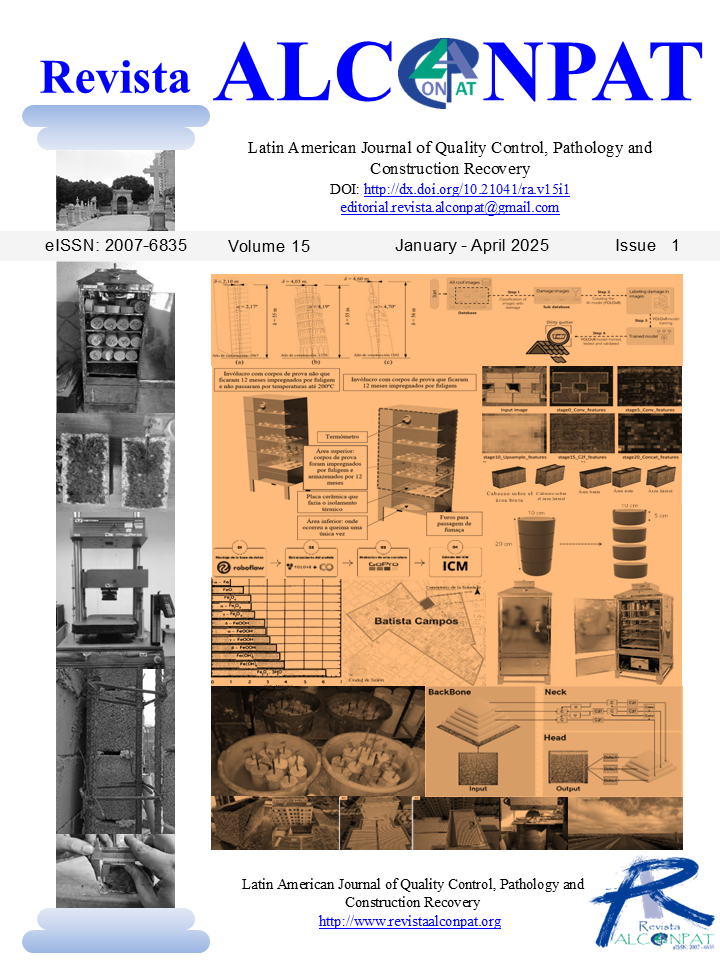Influence of the mortar placement method on the uniaxial compression behavior of hollow concrete blocks
DOI:
https://doi.org/10.21041/ra.v15i1.703Keywords:
masonry, hollow concrete blocks, mortar placementAbstract
The aim of this study was to evaluate how capping placement affects the uniaxial compressive behavior of hollow concrete blocks. Two placement methods were analyzed: 1) on the gross area and 2) on the lateral faces. An experimental program and statistical analysis were conducted to identify significant differences between the methods. The results showed that blocks capped on the lateral faces exhibited a 12.5% decrease in load capacity and an 11.33% decrease in stiffness compared to those capped on the gross area. This study focuses on hollow concrete blocks and concludes that using a variable denominator leads to a misinterpretation of their strength.
Downloads
References
Álvarez-Pérez, J., Chávez-Gómez, J. H., Terán-Torres, B. T., Mesa-Lavista, M., Balandrano-Vázquez, R. (2020), Multifactorial behavior of the elastic modulus and compressive strength in masonry prisms of hollow concrete blocks. Construction and Building Materials, 241: p. 18. https://doi.org/10.1016/j.conbuildmat.2020.118002
Al-Amoudi, M. A. A., Alwathaf, A. H. (2014), The Behavior of Hollow Concrete Block Masonry under Axial Compression. Journal of Engineering Sciences, 3(2): p. 32-53. ISSN 2312-9999.
American Society for Testing and Materials International (2017), ASTM-C-140-17A, Standard test methods for sampling and testing concrete masonry units and related units. p. 26.
American Society for Testing and Materials International (2016), ASTM-C-1552, Standard Practice for Capping Concrete Masonry Units, Related Units and Masonry Prisms for Compression Testing.
Australian Standard (2018), AS 3700:2018, Masonry Structures, Standarsds Australian Limited 2018.
Barbosa, C. S., Hanai, J. B. (2005), Strength and deformability of hollow concrete blocks and their correlations with mechanical properties of constituent material, in 10th Canadian Masonry Symposium. Banff, Alberta, June p. 8-12.
Barbosa, C. S., Hanai, J. B. (2006), Resistência e deformabilidade de blocos vazados de concreto e suas correlações com as propriedades mecânicas do material constituinte. Cadernos de Engenharia de Estruturas. 8(34): p. 45-74.
Barbosa, C. S., Lourenço, P. B., Hanai, J. B. (2010), On the compressive strength prediction for concrete masonry prisms. Materials and Structures, 43(3): p. 331-344. http://dx.doi.org/10.1617/s11527-009-9492-0
Caldeira, F. E., et al. (2020), Influence of joint thickness and strength of mortars on the compressive behavior of prisms made of normal and high-strength concrete blocks. Construction and Building Materials, 234: p. 117419. https://doi.org/10.1016/j.conbuildmat.2019.117419
Canadian Standards Association (CSA) (2004), S304.1-04 - Design of Masonry Structures, p. 139, Published in December, Canada, ISBN 1-55397-402-6. https://es.slideshare.net/slideshow/csa-masonry-s304104/238765983
Eurocode (2005), EN 1996-1 and 2: 2005, Eurocode 6-Design of masonry structures. Part 1-1: General rules for buildings—reinforced and unreinforced masonry, Design of asonry structures. Design Considerations, Selection of Materials and Execution o Masonry. European Committee for Standardisation CEN, Brussels, 2006.
Fortes, E. S., Parsekian, G. A., Camacho, J. S. (2017), Compressive strength of masonry constructed with high strength concrete blocks. Ibracon structures and materials journal, 10(6): p. 1273-1319. http://dx.doi.org/10.1590/S1983-41952017000600008
García, J. M., Bonett, R. L., Ledezma, C. (2013), Analytical Model for Compression Behavior of Hollow Concrete Blocks (In Spanich). Revista de la construcción, 12(3): p. 76-82. http://dx.doi.org/10.4067/S0718-915X2013000300009
Henrique Nalon, G., Rezende Santos, C. F., Pedroti, L. G., Lopes Ribeiro, J. C., Veríssimo, G. S., Ferreira. F. A. (2020), Strength and failure mechanisms of masonry prisms under compression, flexure and shear: Components’ mechanical properties as design constraints. Journal of Building Engineering, 28: p. 101038. https://doi.org/10.1016/j.jobe.2019.101038
Lima, T. E. S., Azevedo, A. R. G., Marvila, M. T., Zanelato, E. B., Paes, A. L. C., Alexandre, J., Monteiro, S. N. (2021), Study of Face Shell Bedding Concrete Blocks Prisms with Different Laying Mortar Strength. in Characterization of Minerals, Metals, and Materials 2021. Cham: Springer International Publishing. https://doi.org/10.1007/978-3-030-65493-1_52
Mahamid, M., Westin, N. (2020), Reevaluation of f´m for the Unit-Strength Method with Application to Ligthweight Concrete Block Masonry and Face Shell-Bedded Mortar Joints. Practice Periodical on Structural Design and Construction, 25(3): p. 10. https://10.1061/(asce)sc.1943-5576.0000494
Martins, R. O. G., Nalon, G. H., Sant'Ana Alvarenga, R. C. S., Pedroti, L. G., Lopes Ribeiro, J. C. (2018), Influence of blocks and grout on compressive strength and stiffness of concrete masonry prisms. Construction and Building Materials, 182: p. 233-241. https://doi.org/10.1016/j.conbuildmat.2018.06.091
Masonry Standards Joint Committee (MSJC) (2013), Building Code Requirements and Specification for Masonry Structures and Companion Commentaries (TMS 602/ACI 530.1/ASCE 6). Produced in the United States of America.
NTC-Mampostería (2023), Norma técnica complementaria para diseño y construcción de estructuras de mampostería. p. 119.
Mohamad, G., Fonseca, F. S., Vermeltfoort, T., Martens, D. R. W., Lourenço, P. B. (2017), Strength, behavior, and failure mode of hollow concrete masonry constructed with mortars of different strengths. Construction and Building Materials, 134: p. 489-496. https://doi.org/10.1016/j.conbuildmat.2016.12.112
Montgomery, D. C., Runger, G. C. (2003), Applied Statistics and Probability for Engineers, Third Edition: Printed in the United States of America.
Mohamad, G., Lourenço, P. B., Roman, H. R. (2007), Mechanics of hollow concrete block masonry prisms under compression: Review and prospects. Cement and Concrete Composites, 29(3): p. 181-192. https://doi.org/10.1016/j.cemconcomp.2006.11.003
Nalon, G. H., Lopes Ribeiro, J. C., Pedroti, L. G., da Silva, R. M., Duarte de Araújo, E. N., Santos, R. F., Soares de Lima, G. E. (2022), Review of recent progress on the compressive behavior of masonry prisms. Construction and Building Materials, 320: p. 126181. https://doi.org/10.1016/j.conbuildmat.2021.126181
Organismo Nacional de Normalización y Certificación de la Construcción y Edificación – ONNCCE (2010), NMX-ONNCCE-C-464, Determinación de la resistencia a compresión diagonal y módulo de cortante de muretes, así como determinación de la resistencia a compresión y módulo de elasticidad de pilas de mampostería de arcilla o de concreto. Métodos de ensayo. p. 24.
Organismo Nacional de Normalización y Certificación de la Construcción y Edificación – ONNCCE (2013), NMX-ONNCCE-C-036, Resistencia a la compresión de bloques, tabiques o ladrillos y tabicones y adoquines– método de ensayo. p. 10.
Sarhat, S. R., Sherwood, E. G. (2014), The prediction of compressive strength of ungrouted hollow concrete block masonry. Construction and Building Materials, 58: p. 111-121. https://doi.org/10.1016/j.conbuildmat.2014.01.025
SPSS (2017), IBM SPSS Statistics for Windows, Version 25.0., N.Y. Armonk, Editor.
Thamboo, J. A., Dhanasekar, M., Yan, C. (2013), Effects of Joint Thickness, Adhesion and Web Shells to the Face Shell Bedded Concrete Masonry Loaded in Compression. Australian Journal of Structural Engineering, 14(3): p. 291-302. https://10.7158/13287982.2013.11465139.
Zahra, T., Thamboo, J., Asad, M. (2021), Compressive strength and deformation characteristics of concrete block masonry made with different mortars, blocks and mortar beddings types. Journal of Building Engineering, 38: p. 102213. https://doi.org/10.1016/j.jobe.2021.102213
Zahra, T., Dhanasekar, M. (2018), Characterisation and strategies for mitigation of the contact surface unevenness in dry-stack masonry. Construction and Building Materials, 169: p. 612-628. https://doi.org/10.1016/j.conbuildmat.2018.03.002
Published
How to Cite
Issue
Section
License
_______________________________
License in effect from September 2020
You are free to:
- Share — copy and redistribute the material in any medium or format for any purpose, even commercially.
- Adapt — remix, transform, and build upon the material for any purpose, even commercially.
- The licensor cannot revoke these freedoms as long as you follow the license terms.
Under the following terms:
- Attribution — You must give appropriate credit , provide a link to the license, and indicate if changes were made . You may do so in any reasonable manner, but not in any way that suggests the licensor endorses you or your use.
- No additional restrictions — You may not apply legal terms or technological measures that legally restrict others from doing anything the license permits.
Notices:
You do not have to comply with the license for elements of the material in the public domain or where your use is permitted by an applicable exception or limitation .
No warranties are given. The license may not give you all of the permissions necessary for your intended use. For example, other rights such as publicity, privacy, or moral rights may limit how you use the material.





















.png)














